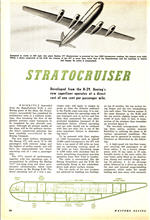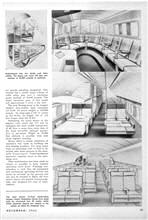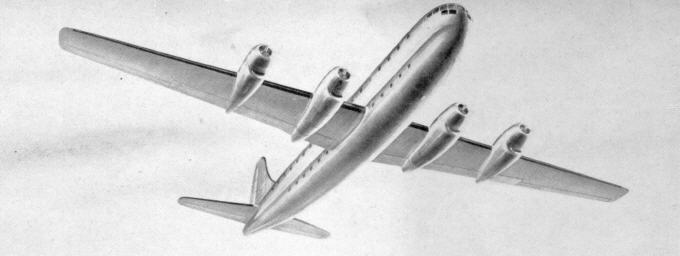

From «Western Flying», December 1944


 |
| Designed to cruise at 340 mph, this giant Boeing 377 Stratocruiser is powered by four 3500 horsepower engines, the largest ever built. While a direct outgrowth of the B-29, the volume of the 377 is more than twice that of the Superfortress and the fuselage is twelve feet longer. Its cabin is pressurized. |
Developed from the B-29, Boeing's new superliner operates at a direct cost of one cent per passenger mile.
DIRECTLY descended from the Superfortress B-29, a new Boeing giant of the skies, the Stratocruiser, successfully has completed its preliminary tests as a military prototype, thus becoming the first of the greater postwar super transports to be completed by any aircraft company. Although all present models of the plane will be for military service, the ship's commercial potential has been carefully considered by the Boeing Company.
The new super airliner, designated the Boeing 377, will carry 72 to 100 passengers with extreme range and the highest of airline speeds, and will have the unprecedented low direct operating cost of 1 cent a passenger mile.
The 377's record of performance, together with low operating cost, is accomplished by utilizing the Boeing "117" low-drag wing and other aerodynamic advancements which have been proven on the Boeing B-29. The direct operating cost of 1 cent a passenger mile, will apply to ranges as great as from the Atlantic seaboard to the Pacific coast non-stop. It is substantially below the operating costs of any transport now in service and less than that announced for any other projected landplane transport of the immediate future. (Direct operating cost per mile should not be confused with fare per mile, but is one of the most important factors in determining fare.)
To be powered with four engines of 3,500 horsepower each at takeoff (2,800 rated horsepower) the 377 will have a top speed of 400 miles an hour and an operating cruising speed of 340 miles an hour. Operating range is 3,500 miles with abundant fuel reserve, permitting economical non-stop operation from New York to London.
The cabin is pressurized, like the Boeing Stratoliner and the B-29, for comfortable flying in the substratosphere high above surface storms.
The two decks of the new airplane are achieved by building one fuselage on top of another, the top section being longer and the two streamlining into each other. The bottom section is the same diameter as the B-29, and the top section slightly larger with a width of more than 11 feet. A crosssection of the airplane thus resembles an inverted figure 8.
 |
The two-deck arrangement, allowing three cabins, permits unusual flexibility in utilizing the plane to fit various operational conditions. The plane can be operated in various combinations as illustrated by the following:
1. A high-speed yet low-fare transport carrying 100 passengers in all three cabins. 2. As a luxury sleeper plane, with 72 day seats or 36 comfortable berths in the main cabin, the rear lower cabin fitted as an observation, dining and cocktail lounge seating 14 persons. 3. As an all-cargo plane, featured by a drive-up ramp in the rear and internal cargo-handling equipment, which make for speedy loading and does away with necessity for special handling equipment. This version has a usable cargo volume of 3,000 cubic feet and a maximum cargo payload of 35,000 pounds. The direct operation costs of this model will approximate 5 cents a ton mile.
| Stratocruiser has two decks and three cabins. The plane can carry 100 day passengers or 35,000 pounds of payload. |
 |
The new Boeing giant is the largest modern four-engine land transport yet built. Its gross weight is 130,000 pounds. Its wing span is 141'3" (same as the B-29), its length 110' 4" (12 feet longer than the B-29).
Indicating the great power of the engines with which the 377 will be equipped, the total 14,000 horsepower of all four is more than twice that of the most powerful railroad locomotive in operation. Flight at 20,000 feet altitude is possible with only three engines running.
Every effort to attain simplicity of operation was made in building the new Boeing airplane. For long ocean hops, an operating crew of four is required, plus three persons in the steward's department. Transcontinental operation requires three in the operating crew.
Ship maintenance has been made as simple as possible to keep indirect operating costs down. Fuselage construction is such that all equipment and mechanical operating devices can easily be serviced on the ground and can also be reached in flight. All four power plants are quickly interchangeable, and designed for ease of maintenance.
 |
 |
 |
| Top view shows 14-chair observation lounge. Center illustration shows how seats may be converted into 36 berths while lower drawing depicts the largest of the cabins as fitted for cheapest fare. |